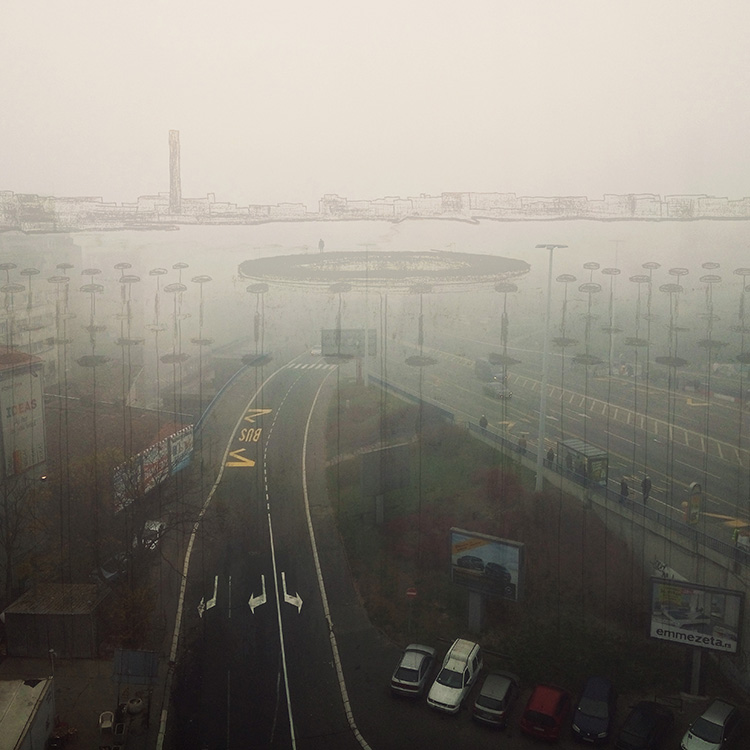
Spaces of Freedom
Bojana Rankovic
- “Action; production of an event in the strange territory: casual unfolding of a particular proposal which is superimposed on the already existing; repeated void on the void of the city; silent artificial landscape touching the historical time of the city yet neither cancelling it nor imitating it. Flow, force, incorporation, independence of the forms, expression of the lines that cross it. Beyond the art that unveils new freedoms.”
– Ignasi de Sola Morales, “Terrain Vague”
freedom
find your crack
in this broken world
and express
your desire,
your hope,
your struggle
say what that is
to you
say
and never stop saying
because that is
freedom

Freedom, by author
spaces of freedom
Standing on the threshold of the past and the future, spaces of freedom are existing in the liminal position of the present moment. They are a gap in the urban fabric, in time, in one’s mind. They are an integral part of the city as they live within it, “feeding on its refuse and offering their presence as a new nature, a forgotten future” 1.
They reflect the city and its changes, as the city also lives within them through the manifestation of its entropy. Through spaces of freedom, one perceives the awareness of the city – “the transient character of matter, time and space” 2.
Spaces of freedom are fluid, changeable, ungraspable but also constant and present. The loss of function and definition resulting in spatial disorder and unpredictability opens the discovery of new experiential and spatial qualities. Through this work, I aim to uncover those features.
In psychogeography, two ambiances are distinguished: hard – which is about the actual, static, physical construction; and soft – which is about light, sound, time, and association of the ideas. Hard is rendered by soft 3.
This interplay of hard-soft and their interdependence is used as a methodology to capture the relationship between the city and the emotions. Physical and immaterial, tangible and ungraspable, logical and irrational – the so-called reality is always rendered by personal experiences, the world is perceived by emotions.
This work presents a collection of personal drawings, photographs, and thoughts. They are a self-reflective medium for understanding reality. It consists of two parts: 1) conditions and 2) possibilities. “Conditions” aim to present the atmospheres of spaces of freedom, while “possibilities” suggest guiding principles or “tools” for enhancing their true value – one of free, open, and universal character.
Conditions
ambiguous
spaces without function and purpose
with no defined conditions
spaces without control and expectations
with no rules of behavior
i want to be there
as there i can breathe

Ambiguous, Tallinn, Estonia, 2018, by author
fleeting
did it disappear
if it is not here
does it not exist
if it has no function
don’t you feel (?)
if you know but do not see

Fleeting, Tallinn, Estonia, 2018, by author
neglected
if you see:
abandoned
broken
without use
without purpose
left to be forgotten
and shaped by the time,
come
and check again:
it still moves
it’s still alive.

Neglected, Tallinn, Estonia, 2018, by author
in between
there is no top or bottom
there is no inside or outside
this is not the space of duality
but the space of unity
being on the top is one of many steps
and being at the bottom is a step closer
inside doesn’t mean security
and outside isn’t only fear
everything is a part of same
continuum or emptiness
where opposites
do not exist

In between, Belgrade, Serbia, 2016, by author
Possibilities
appropriation
i do not need to have
in order to be
and i do not need to own
so that it is mine
i always see the other perspective
and that is why i am and always will be – rich

Appropriation, Kladovo, Serbia, 2017, by author
experience
is it the air
that’s heavy
could be sun
that sleeps
maybe the waves
that are breaking
or just our footsteps
as we leave

Experience, Tallinn, Estonia, 2018, by author
community
living together
i wonder sometimes
where is the line
between me, you and us
the city is ours
the city is us
so how do you stop
between me, you and us
to share and to give
and to build trust
as that is the way
for resilient times

Community, Belgrade, Serbia, 2017, by author
event
event creates the space
so space becomes a stage
stage where anyone can walk
and be part of the play
space of playing and being
of living and being alive
ephemeral and indefinite
abstract and close
space for everyone
as events are made by anyone

Event, Rabat, Morocco, 2019, by author
Notes
1. Careri, F. (2012). Walkscapes: Walking as an Aesthetic Practice. Barcelona: Editorial Gustavo Gili, p.12.
2. Ibid, p. 25.
3. Wolf, Charles R. (2016). Seeing the Better City: How to Explore, Observe, and Improve Urban Space. Washington, DC: Island Press, p. 12.
Bojana Rankovic has obtained her bachelor diploma at the Faculty of Architecture, at the University of Belgrade, after which she continued her masters studies in Belgium, at KU Leuven University. She graduated on the topic “Placeless Places” through which she developed the interest for a more holistic understanding of architecture and space itself. After graduating (2019), she had the opportunity to work on architecture projects touching on the ideas of public space and its use in the Netherlands and Morocco. Through the practice, she is focusing on the city, people and (un)use of space. In the search for a framework which combines exploration of space and social engagement through art, Bojana decided to continue her education enrolling in the PhD program “Scene Design” at University of Novi Sad with an ambition to define the “Spaces of Freedom”.
Volume 5, no. 2 Jun-Dec 2022
